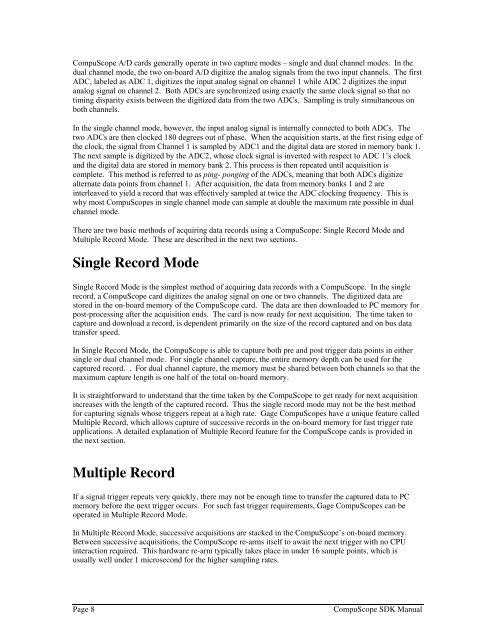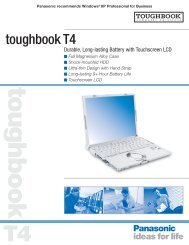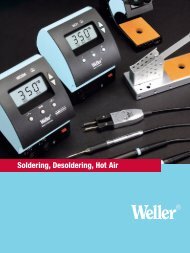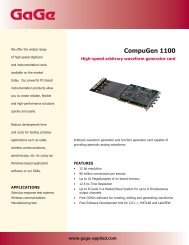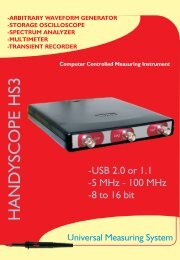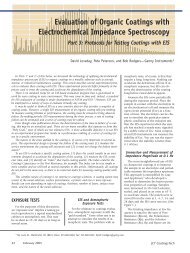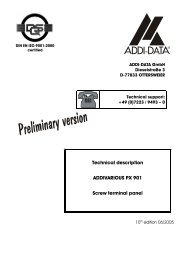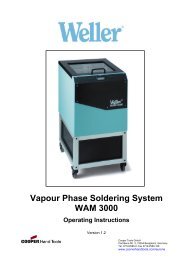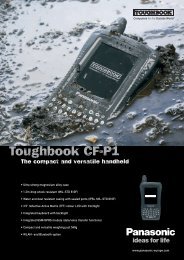CompuScope SDK Manua.. - Egmont Instruments
CompuScope SDK Manua.. - Egmont Instruments
CompuScope SDK Manua.. - Egmont Instruments
You also want an ePaper? Increase the reach of your titles
YUMPU automatically turns print PDFs into web optimized ePapers that Google loves.
<strong>CompuScope</strong> A/D cards generally operate in two capture modes – single and dual channel modes. In thedual channel mode, the two on-board A/D digitize the analog signals from the two input channels. The firstADC, labeled as ADC 1, digitizes the input analog signal on channel 1 while ADC 2 digitizes the inputanalog signal on channel 2. Both ADCs are synchronized using exactly the same clock signal so that notiming disparity exists between the digitized data from the two ADCs. Sampling is truly simultaneous onboth channels.In the single channel mode, however, the input analog signal is internally connected to both ADCs. Thetwo ADCs are then clocked 180 degrees out of phase. When the acquisition starts, at the first rising edge ofthe clock, the signal from Channel 1 is sampled by ADC1 and the digital data are stored in memory bank 1.The next sample is digitized by the ADC2, whose clock signal is inverted with respect to ADC 1’s clockand the digital data are stored in memory bank 2. This process is then repeated until acquisition iscomplete. This method is referred to as ping- ponging of the ADCs, meaning that both ADCs digitizealternate data points from channel 1. After acquisition, the data from memory banks 1 and 2 areinterleaved to yield a record that was effectively sampled at twice the ADC clocking frequency. This iswhy most <strong>CompuScope</strong>s in single channel mode can sample at double the maximum rate possible in dualchannel mode.There are two basic methods of acquiring data records using a <strong>CompuScope</strong>: Single Record Mode andMultiple Record Mode. These are described in the next two sections.Single Record ModeSingle Record Mode is the simplest method of acquiring data records with a <strong>CompuScope</strong>. In the singlerecord, a <strong>CompuScope</strong> card digitizes the analog signal on one or two channels. The digitized data arestored in the on-board memory of the <strong>CompuScope</strong> card. The data are then downloaded to PC memory forpost-processing after the acquisition ends. The card is now ready for next acquisition. The time taken tocapture and download a record, is dependent primarily on the size of the record captured and on bus datatransfer speed.In Single Record Mode, the <strong>CompuScope</strong> is able to capture both pre and post trigger data points in eithersingle or dual channel mode. For single channel capture, the entire memory depth can be used for thecaptured record. . For dual channel capture, the memory must be shared between both channels so that themaximum capture length is one half of the total on-board memory.It is straightforward to understand that the time taken by the <strong>CompuScope</strong> to get ready for next acquisitionincreases with the length of the captured record. Thus the single record mode may not be the best methodfor capturing signals whose triggers repeat at a high rate. Gage <strong>CompuScope</strong>s have a unique feature calledMultiple Record, which allows capture of successive records in the on-board memory for fast trigger rateapplications. A detailed explanation of Multiple Record feature for the <strong>CompuScope</strong> cards is provided inthe next section.Multiple RecordIf a signal trigger repeats very quickly, there may not be enough time to transfer the captured data to PCmemory before the next trigger occurs. For such fast trigger requirements, Gage <strong>CompuScope</strong>s can beoperated in Multiple Record Mode.In Multiple Record Mode, successive acquisitions are stacked in the <strong>CompuScope</strong>’s on-board memory.Between successive acquisitions, the <strong>CompuScope</strong> re-arms itself to await the next trigger with no CPUinteraction required. This hardware re-arm typically takes place in under 16 sample points, which isusually well under 1 microsecond for the higher sampling rates.Page 8<strong>CompuScope</strong> <strong>SDK</strong> <strong>Manua</strong>l


